Wireless Access Point
The Command Line Interface 495
Sample Configuration Tasks
This section provides examples of some of the common configuration tasks used
with the Wireless AP, including:
“Configuring a Simple Open Global SSID” on page 496.
“Configuring a Global SSID using WPA-PEAP” on page 497.
“Configuring an SSID-Specific SSID using WPA-PEAP” on page 498.
“Enabling Global IAPs” on page 499.
“Disabling Global IAPs” on page 500.
“Enabling a Specific IAP” on page 501.
“Disabling a Specific IAP” on page 502.
“Setting Cell Size Auto-Configuration for All IAPs” on page 503
“Setting the Cell Size for All IAPs” on page 504.
“Setting the Cell Size for a Specific IAP” on page 505.
“Configuring VLANs on an Open SSID” on page 506.
“Configuring Radio Assurance Mode (Loopback Tests)” on page 507.
To facilitate the accurate and timely management of revisions to this section, the
examples shown here are presented as screen images taken from a Secure Shell
(SSH) session (in this case, PuTTY). Depending on the application you are using
to access the Command Line Interface, and how your session is set up (for
example, font and screen size), the images presented on your screen may be
different than the images shown in this section. However, the data displayed will
be the same.
Some of the screen images shown in this section have been modified for clarity.
For example, the image may have been “elongated” to show all data without the
need for additional images or scrolling. We recommend that you use the Adobe
PDF version of this User’s Guide when reviewing these examples — a hard copy
document may be difficult to read.
As mentioned previously, the root command prompt is determined by the host
name assigned to your AP.

